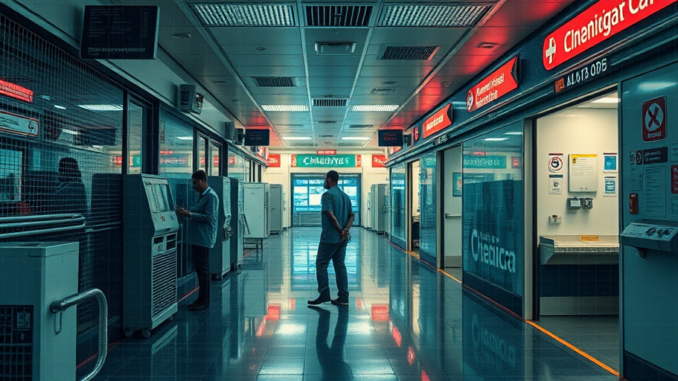
Summary
A ransomware attack targeted Alder Hey Children’s Hospital, Liverpool Heart and Chest Hospital, and Royal Liverpool University Hospital. The attack, attributed to INC Ransom, exploited a shared digital gateway, resulting in data exfiltration. While hospital services remain operational, the incident raises concerns about cybersecurity in healthcare.
Main Story
You know, the digital side of healthcare is becoming a real magnet for cyberattacks, it’s worrying. Take what happened recently in Liverpool, with Alder Hey Children’s Hospital, Liverpool Heart and Chest Hospital, and Royal Liverpool University Hospital being targeted. A single cyber attack hit all three, can you believe it? INC Ransom, a known ransomware group, is apparently behind it. They exploited a shared digital gateway, which I find quite concerning; its like finding out all the locks in your building use the same key!
It all came to light on November 28, 2024, when INC Ransom published what they claimed were stolen data screenshots. Patient and donor info, medical reports, even financial records are said to be part of the haul. At first, Alder Hey was cagey, saying they were checking things out. But subsequent statements, they did confirm the attack touched all three hospitals. Thankfully, and this is some good news, the data, they said, doesn’t seem to involve children.
Right now, there’s a lot going on, as you might expect. Hospitals, the National Crime Agency (NCA), and the Information Commissioner’s Office are all investigating to figure out the full extent of it all. The main aim, of course, is to shore up their systems to prevent any further access. That shared digital gateway though, that’s the real kicker. It shows just how interconnected everything is, a vulnerability in one system can cause problems for a whole network. It’s a domino effect you just don’t want to see.
And this isn’t some random, isolated incident; not at all. Healthcare is basically a big bullseye for cybercriminals. Patient data is highly sensitive, and hospitals are vital parts of our society. Which makes them prime targets for disruption or financial gain, sadly. For example, HIPAA Journal reported quite a few cyberattacks in 2024 on the healthcare sector; big names too like Change Healthcare and Ascension Health. Even big, well-resourced places are vulnerable. This just underscores the absolute need for solid cybersecurity measures.
So, why are healthcare systems so vulnerable, you might ask? Several things. Legacy systems, for starters. All those interconnected devices and networks don’t help either, and quite often, resources for cybersecurity are thin on the ground. Smaller hospitals are particularly at risk here, because of tighter budgets and fewer staff. It’s a tough situation, really. With cyberattacks growing in complexity, it’s crucial that healthcare institutions increase their cybersecurity investments. It really needs to be a priority, to protect both operations and, crucially, our patient data.
The consequences of this attack reach way beyond any immediate disruption, though. Patient privacy is a huge concern, imagine your personal data being in the wrong hands. Plus, this incident also highlights the real and present threat of ransomware attacks, I mean, what are you supposed to do when you’re balancing patient care and the demands of some faceless cybercriminal? The UK’s position is not to pay ransom demands, which is good policy, of course, but places a lot of pressure on the hospitals to recover.
Looking ahead, it’s clear that healthcare organizations need to be proactive. That means investing in robust security systems, and training their staff properly, it’s no good having good systems if your staff are not trained to use them properly. Regularly checking for weaknesses with penetration tests is vital, too. Furthermore, collaboration between hospitals, the government, and cybersecurity experts is vital to develop solutions. Clear and consistent communication with patients and the public is also essential, transparency builds trust. The whole situation, with what happened at Alder Hey, and the other hospitals serves as a stark reminder. We absolutely must focus on increasing cybersecurity measures within the healthcare sector. I’d say, it’s not just important, it’s actually critical.


The interconnected nature of digital gateways highlights the critical need for robust network segmentation in healthcare. Are there specific strategies that hospitals can employ to limit the spread of attacks via shared access points?
That’s a great point about network segmentation! I think exploring micro-segmentation strategies could be really beneficial, potentially creating isolated zones for different services or even departments. This would limit lateral movement in the event of a breach and improve overall security.
Editor: MedTechNews.Uk
Thank you to our Sponsor Esdebe – https://esdebe.com
A shared digital gateway, you say? So, like a single, unlocked door to *three* hospitals? Were they also sharing a password written on a sticky note under the keyboard? Just curious how something *that* obvious could be missed in the first place.
That’s a great analogy! It really does highlight the seemingly obvious oversight. The interconnectedness of systems, while beneficial, creates these single points of failure if not properly secured. It’s a reminder that even the most basic security practices need constant review and reinforcement.
Editor: MedTechNews.Uk
Thank you to our Sponsor Esdebe – https://esdebe.com
A shared digital gateway, you say? Like a central hub for data, convenient for cybercriminals too, it seems. Perhaps they should consider a digital moat and drawbridge next time.
I love the moat and drawbridge analogy! It’s a great way to visualize the need for layered security. Perhaps we need to move away from thinking of single ‘gateways’ and instead adopt more sophisticated security architectures which restrict access and contain threats. It’s certainly something to explore further.
Editor: MedTechNews.Uk
Thank you to our Sponsor Esdebe – https://esdebe.com